Empirical evidence for the effect of airline travel on inter-regional influenza spread in the United States
- PMID: 16968115
- PMCID: PMC1564183
- DOI: 10.1371/journal.pmed.0030401
Empirical evidence for the effect of airline travel on inter-regional influenza spread in the United States
Abstract
Background: The influence of air travel on influenza spread has been the subject of numerous investigations using simulation, but very little empirical evidence has been provided. Understanding the role of airline travel in large-scale influenza spread is especially important given the mounting threat of an influenza pandemic. Several recent simulation studies have concluded that air travel restrictions may not have a significant impact on the course of a pandemic. Here, we assess, with empirical data, the role of airline volume on the yearly inter-regional spread of influenza in the United States.
Methods and findings: We measured rate of inter-regional spread and timing of influenza in the United States for nine seasons, from 1996 to 2005 using weekly influenza and pneumonia mortality from the Centers for Disease Control and Prevention. Seasonality was characterized by band-pass filtering. We found that domestic airline travel volume in November (mostly surrounding the Thanksgiving holiday) predicts the rate of influenza spread (r(2) = 0.60; p = 0.014). We also found that international airline travel influences the timing of influenza mortality (r(2) = 0.59; p = 0.016). The flight ban in the US after the terrorist attack on September 11, 2001, and the subsequent depression of the air travel market, provided a natural experiment for the evaluation of flight restrictions; the decrease in air travel was associated with a delayed and prolonged influenza season.
Conclusions: We provide the first empirical evidence for the role of airline travel in long-range dissemination of influenza. Our results suggest an important influence of international air travel on the timing of influenza introduction, as well as an influence of domestic air travel on the rate of inter-regional influenza spread in the US. Pandemic preparedness strategies should account for a possible benefit of airline travel restrictions on influenza spread.
Conflict of interest statement
Figures




Comment in
-
Air travel and the spread of influenza: important caveats.PLoS Med. 2006 Nov;3(11):e503; author reply e502. doi: 10.1371/journal.pmed.0030503. PLoS Med. 2006. PMID: 17132057 Free PMC article. No abstract available.
References
-
- Grais RF, Ellis JH, Kress A, Glass GE. Modeling the spread of annual influenza epidemics in the U.S.: The potential role of air travel. Health Care Manag Sci. 2004;7:127–134. - PubMed
-
- Longini IM, Jr, Fine PE, Thacker SB. Predicting the global spread of new infectious agents. Am J Epidemiol. 1986;123:383–391. - PubMed
-
- Rvachev L, Longini I. A mathematical model for the global spread of influenza. Math Biosci. 1985;75:3–22.
-
- Flahault A, Deguen S, Valleron AJ. A mathematical model for the European spread of influenza. Eur J Epidemiol. 1994;10:471–474. - PubMed
-
- Grais RF, Ellis JH, Glass GE. Assessing the impact of airline travel on the geographic spread of pandemic influenza. Eur J Epidemiol. 2003;18:1065–1072. - PubMed
Publication types
MeSH terms
Grants and funding
LinkOut - more resources
Full Text Sources
Other Literature Sources
Medical

